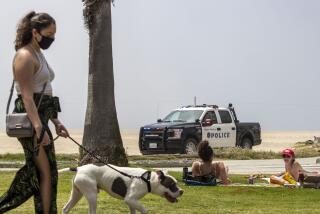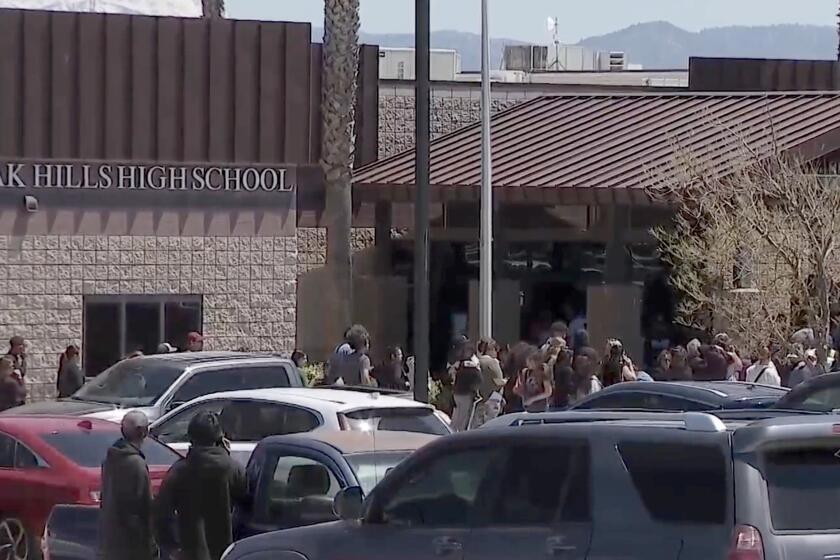Lake Los Angeles residents might get serial rapist for a neighbor
A serial rapist linked to attacks on dozens of women could be released to the Antelope Valley when he is freed soon from a state mental hospital, authorities said Friday.
A state contractor announced at a court hearing that a single-family home in the unincorporated area of Lake Los Angeles had been found for Christopher Hubbart, according to a prosecutor who attended the hearing. The home is a few miles east of Palmdale.
Residents and government officials from northern Los Angeles County reacted with outrage to the news, with some saying they plan to urge the judge overseeing Hubbart’s case to reject the location.
“They’re taking someone who is not from here — who has a horrific criminal record — and they’re dumping him in the Antelope Valley,” said John Mlynar, a spokesman for the city of Palmdale. “We don’t think that’s right.”
Hubbart, who has spent nearly two decades in a state mental hospital, admitted sexually assaulting more than three dozen women throughout California between 1971 and 1982, according to the Los Angeles County district attorney’s office.
The proposed location for his home was announced at a court hearing in San Jose, where a judge earlier this year ruled that Hubbart should be freed under tight supervision. Santa Clara County Superior Court Judge Gilbert Brown previously rejected arguments that Hubbart should be released in the Bay Area, where his most recent crimes were committed, and said he should return to Los Angeles County, where he grew up and lived briefly the last time he was released from prison in 1993.
Brown will consider objections to the location but could order Hubbart’s release to the home at his next court hearing in San Jose on Dec. 4, said Santa Clara County Deputy Dist. Atty. Vonda Tracey, who was at Friday’s hearing.
Tracey said Hubbart will initially have constant supervision at his new home. He will also be required to wear a GPS ankle bracelet that alerts authorities if he violates his curfew or ventures near prohibited areas, such as local parks and schools, she said. His access to the Internet will be restricted, Tracey said, and he will be subject to random searches and must attend sex offender treatment sessions.
“We all know that no one wants this guy living near them, so our goal is to put out as much information as possible so that the public knows how closely monitored he’s going to be so that they feel safer,” Tracey said.
State authorities overseeing such releases often have difficulty finding landlords willing to rent to convicted sex offenders, she said. In addition, state law prohibits sex offenders from living within 2,000 feet of a school or park.
Tracey said general opposition from the public is unlikely to sway the judge from accepting the location. “It usually has to be something more: say, one of Mr. Hubbart’s previous victims lives in the area,” she said.
Hubbart’s attorney, Santa Clara County Deputy Public Defender Jeff Dunn, said earlier this year that his client had embraced intensive treatment for years while locked up in a state mental hospital and is not a public safety risk. He said Hubbart’s request for release was supported by his treating psychologist at Coalinga State Hospital and the hospital’s medical director.
Dunn could not be reached for comment Friday.
The Los Angeles County D.A.’s office has set up a page on its website to accept comments about the suitability of the proposed location, which is on the 17100 block of Laredo Vista Avenue. Comments can be submitted until Nov. 29, and members of the public also can address the judge at the Dec. 4 hearing, said district attorney’s spokeswoman Jane Robison.
Hubbart is among more than 500 offenders in California who have been confined under a law that allows authorities to commit sexually violent predators to state hospitals if they are deemed to have mental disorders that make them likely to re-offend, even if — as with Hubbart — they have already served their entire prison sentences.
Hubbart was first arrested in 1972 on suspicion of a string of rapes in Los Angeles and San Bernardino counties. He admitted raping about 20 women in the area, according to court records. Hubbart was released from a state hospital in 1979, when state doctors determined that he no longer posed a threat, a federal appeals court said. After moving to the Bay Area, Hubbart committed more sexual assaults during the next two years, according to Los Angeles County prosecutors.
A Lake Los Angeles resident who has lived on Laredo Vista Avenue for nearly a quarter century said he often travels and would be afraid of leaving his wife alone if Hubbart were to move to his street.
“It really angers me,” said the resident, who requested anonymity after expressing concern for his safety and privacy. “My wife and I are getting to the point where we’re anxious to leave California anyway. That might get us to ... move quicker.”
Tony Bell, a deputy to county Supervisor Michael D. Antonovich, said his boss was “outraged by the court’s reckless decision to release this self-admitted violent sexual predator into Lake Los Angeles — or any community.”
More to Read
Start your day right
Sign up for Essential California for news, features and recommendations from the L.A. Times and beyond in your inbox six days a week.
You may occasionally receive promotional content from the Los Angeles Times.







